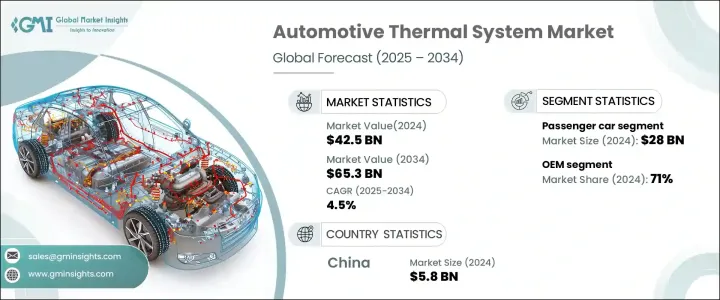
세계의 자동차 열 시스템 시장은 2024년에 425억 달러에 이르렀으며, 2025-2034년 연평균 복합 성장률(CAGR) 4.5%로 성장할 것으로 예측됩니다.
소비자가 편안함, 럭셔리 및 연비 효율을 점점 더 우선시함에 따라 자동차 제조업체는 최신 자동차에 첨단 열 관리 솔루션을 통합하고 있습니다. 온도 제어 시트에서 효율적인 냉난방 시스템까지 열 기술의 혁신이 자동차 분야의 미래를 형성하고 있습니다.

스티어링 휠의 히터나 쿨러, 습도 조정, 멀티존 클라이메이트 컨트롤 등, 쾌적성의 향상을 특징으로 하는 고급차에 대한 수요 증가가 시장의 성장을 가속시키고 있습니다. 게다가 열교환용 고성능 폴리머 재료의 사용 등 재료 과학의 진보가 열 시스템의 효율을 더욱 최적화하고 있습니다. 환경 문제에 대한 관심이 높아지면서 규제의 틀이 엄격해지는 가운데 자동차 회사들은 차량 성능 향상, 연비 개선, 배출가스 감축을 목적으로 차세대 열 시스템에 대한 투자를 진행하고 있습니다. 이러한 요인들로 인해 열 관리는 현대 자동차의 진화에 중요한 구성 요소로 자리 잡고 있습니다.
| 시장 범위 | |
|---|---|
| 시작 연도 | 2024년 |
| 예측 연도 | 2025-2034년 |
| 시작 금액 | 425억 달러 |
| 예측 금액 | 653억 달러 |
| CAGR | 4.5% |
시장은 용도별로 파워트레인 냉각, HVAC, 배터리 열 관리, 폐열 회수, 시트 냉난방으로 구분됩니다. 파워트레인 냉각은 연료 효율 향상과 배출가스 최소화에 중요한 역할을 하기 때문에 이 부문을 지배하고 있습니다. 효과적인 열 관리는 차량 성능에 직접적인 영향을 미치기 때문에 고성능 라디에이터, 인터쿨러, 워터펌프는 엔진 온도 유지에 필수적입니다. 전 세계적으로 배기가스 규제가 갈수록 엄격해지는 가운데, 자동차 제조업체는 뛰어난 방열성, 엔진 수명의 연장, 차량 전체의 신뢰성을 확보하기 위해, 고도의 냉각 기술을 활용하고 있습니다. 열 솔루션은 에너지 효율이 높고 친환경적인 운송에 필수적인 것이 되고 있어 자동차 제조업체는 주행 성능을 향상시키면서 규제 기준을 준수할 수 있습니다.
자동차 열 시스템 시장은 차종별로 분류되어 승용차가 부문을 선도하고 있습니다. 승용차는 2024년에 280억 달러를 창출했으며, 프리미엄한 쾌적성 및 고도의 공조 제어 기능에 대한 소비자 수요의 고조가 그 원동력이 되고 있습니다. 자동차 제조업체는, 보다 쾌적한 운전 체험을 요구하는 소비자의 기호에 응하기 위해, 공기 청정, 멀티 존 온도 제어, 습도 조정 등의 혁신을 포함하는 HVAC 시스템을 강화하고 있습니다. 전기차와 하이브리드차의 채용이 증가하고 있으며 효율적인 열 관리는 배터리의 성능을 최적화하고 항속거리를 늘리기 위해 필수적이기 때문에 이 시장은 더욱 강화되고 있습니다.
아시아태평양은 2024년에 자동차 열 시스템 시장에서 35%의 점유율을 차지했으며, 중국이 지배적인 기업으로 대두해 왔습니다. 이 나라는 전기차 분야에서 주도권을 쥐고 있어 최첨단 열 관리 기술, 특히 배터리 냉각 및 차량 내 공조 제어에 대한 수요가 가속화되고 있습니다. 정부의 특혜나 엄격한 배기가스 정책이 전기차로의 이행을 재촉하는 가운데, 자동차 제조업체는 효율과 성능을 높이기 위해, 액냉 배터리 팩이나 폐열 회수 시스템 등의 혁신적인 냉각 솔루션을 도입하고 있습니다. 이러한 진보에 의해, 중국은 세계의 자동차 열 시스템 시장에 있어서 중요한 성장 거점으로서 자리매김하고 있어 이 지역의 시장 점유율 확대에 공헌하고 있습니다.
The Global Automotive Thermal System Market reached USD 42.5 billion in 2024 and is projected to grow at a CAGR of 4.5% between 2025 and 2034. As consumers increasingly prioritize comfort, luxury, and fuel efficiency, automakers are integrating advanced thermal management solutions into modern vehicles. From temperature-controlled seats to efficient heating and cooling systems, innovations in thermal technology are shaping the future of the automotive sector.

The rising demand for luxury vehicles featuring enhanced comfort settings, such as heated and cooled steering wheels, humidity control, and multi-zone climate control, is accelerating market growth. Furthermore, advancements in material science, including the use of high-performance polymer materials for heat exchange, are further optimizing thermal system efficiency. With growing environmental concerns and stringent regulatory frameworks, automakers are investing in next-generation thermal systems to enhance vehicle performance, improve fuel efficiency, and reduce emissions. These factors are positioning thermal management as a critical component in the evolution of modern automobiles.
| Market Scope | |
|---|---|
| Start Year | 2024 |
| Forecast Year | 2025-2034 |
| Start Value | $42.5 Billion |
| Forecast Value | $65.3 Billion |
| CAGR | 4.5% |
The market is segmented by application into powertrain cooling, HVAC, battery thermal management, waste heat recovery, and seat heating and cooling. Powertrain cooling dominates the segment due to its crucial role in improving fuel efficiency and minimizing emissions. Effective thermal management directly impacts vehicle performance, making high-performance radiators, intercoolers, and water pumps essential for maintaining engine temperature. With increasingly strict emissions regulations worldwide, automakers are leveraging advanced cooling technologies to ensure superior heat dissipation, prolonged engine lifespan, and overall vehicle reliability. Thermal solutions are becoming indispensable for energy-efficient and environmentally friendly transportation, enabling automakers to comply with regulatory standards while enhancing driving performance.
The automotive thermal system market is also categorized by vehicle type, with passenger cars leading the segment. Passenger vehicles generated USD 28 billion in 2024, driven by growing consumer demand for premium comfort and advanced climate control features. Automakers are enhancing HVAC systems to include innovations such as air purification, multi-zone temperature control, and humidity regulation, catering to consumer preferences for a more comfortable driving experience. The increasing adoption of electric and hybrid vehicles further strengthens this market, as efficient thermal management is essential for optimizing battery performance and extending vehicle range.
Asia Pacific held a 35% share of the automotive thermal system market in 2024, with China emerging as a dominant player. The country's leadership in the electric vehicle sector is driving an accelerated demand for cutting-edge thermal management technologies, particularly for battery cooling and cabin climate control. As government incentives and stringent emissions policies encourage the transition to electric mobility, automakers are implementing innovative cooling solutions, such as liquid-cooled battery packs and waste heat recovery systems, to enhance efficiency and performance. These advancements are positioning China as a key growth hub in the global automotive thermal system market, contributing to the region's expanding market share.